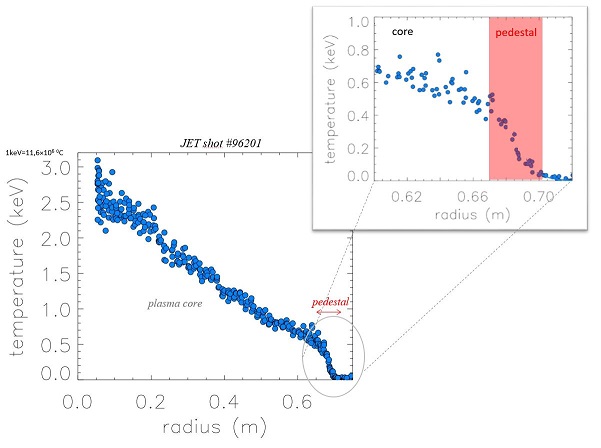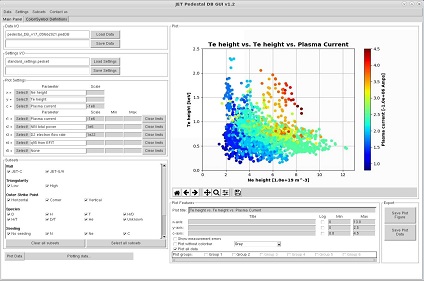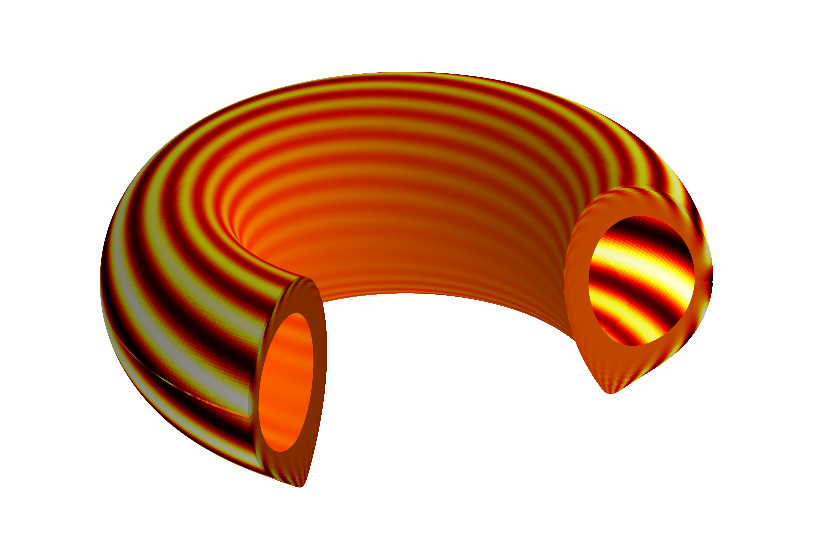Pedestal Physics
The pedestal physics group at the Division for Fusion Plasma Physics is led by Associate Professor Lorenzo Frassinetti. Research activities include experimental work on several major European tokamaks as well as modelling work.
What is the pedestal?
The highest temperature and stored energy in a fusion plasma are obtained in a regime called “H-mode” (which stands for High confinement mode). The edge of an H-mode plasma is characterized by a steep increase of the temperature. The region characterized by this steep increase is called “pedestal”. Figure 1 shows an example of the temperature profile in a plasma obtained at JET, where the pedestal and its steep temperature gradient is highlighted.

The physics of the pedestal region is extremely important because high pedestal temperature leads to high core temperature (due to a property called core profile stiffness) and high fusion plasma performance. Understanding the physics of the pedestal is therefore necessary to optimize fusion performance and guarantee the success of ITER.
People with a basic background in fusion plasma physics can find an introductory lecture on pedestal physics here (pdf 3.0 MB) .
What do we do in the pedestal group?
The physics of the pedestal is not yet fully understood. For example, it is possible to predict the pedestal structure in JET only in very specific experimental conditions.
The group has experimental activities, database and data analysis activities, and theory/modelling activities.
- Experimental activities. We plan, execute and analyze experiments in the major fusion devices in Europe in order to identify the physics mechanisms that are still missing in the present theoretical understanding. Our experimental activity is done through collaborations with the four major European devices:
- JET at UKAEA, in Oxfordshire (United Kingdom)
- AUG at IPP, in Munich (Germany)
- TCV at EPFL, in Lausanne (Switzerland)
- MAST-U at UKAEA, in Oxfordshire (United Kingdom)

Figure 2. GUI (written in Python) to read and plot the JET pedestal database. Part of the Master thesis work of M. Eichenberger. - Database and data analysis activities. We have developed, we coordinate and we maintain the JET pedestal database. We coordinate the pedestal database activity in the European fusion devices: AUG, JET, MAST-U and TCV. An example taken from a master's project is in Figure 2, which shows the Python GUI written by a master's student to read and plot the JET pedestal database.
- Theory/modelling activities. We are testing the present theoretical models to predict the pedestal structure and we try to improve them by adding new physics mechanisms. The present models are based on the idea that the pedestal is limited by “peeling-balloning” modes. The peeling-balloning modes are a type of magnetohydrodynamic (MHD) instability that occurs at the plasma edge in the pedestal region. An example taken from a PhD project is shown in Figure 3, where the 3D perturbation produced by a peeling mode in JET is shown.

Master thesis and PhD thesis in pedestal physics.
We do not provide a list of available theses, as the field moves fast and we cannot keep the list up-to-date. However, for Master's thesis we can provide two types of projects:
- “Experimental data analysis” projects. This type of projects consists in analyzing the experimental data of the pedestal and compare with earlier results and/or modelling results. This type of work requires a good knowledge of fusion plasma physics and good knowledge of programming languages such as Python, MATLAB or IDL.
- “Modelling” projects. This type of projects consists of using already developed tools to model the pedestal. The work could be either modelling of JET pedestals and comparison with experimental results or pedestal prediction for new machines, such as DTT or ITER . This type of work requires a good knowledge of fusion plasma physics and good knowledge of programming languages such as Python, MATLAB or IDL.
Doctoral positions are announced via the official KTH portal.
